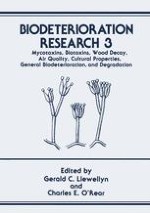1990 | OriginalPaper | Buchkapitel
Interactive Effects of Multiple Mycotoxin Contamination of Swine Diets
verfasst von : M. T. Coffey, W. M. Hagler Jr., E. E. Jones, J. M. Cullen
Erschienen in: Biodeterioration Research
Verlag: Springer US
Enthalten in: Professional Book Archive
Aktivieren Sie unsere intelligente Suche, um passende Fachinhalte oder Patente zu finden.
Wählen Sie Textabschnitte aus um mit Künstlicher Intelligenz passenden Patente zu finden. powered by
Markieren Sie Textabschnitte, um KI-gestützt weitere passende Inhalte zu finden. powered by
Mycotoxin contamination in grains and feedstuffs is a serious agricultural and public health problem. Mycotoxins are causative agents in numerous disease syndromes in swine (Hesseltine, 1979). Over 200 mycotoxins have been identified but relatively few have been confirmed in mycotoxicoses (Tuite, 1979). Aflatoxin B1 (AFB1), which is produced by the fungal genus Aspergillus. has been studied the most extensively. Species of the genus Fusarium that produce zearalenone (ZE) and trichothecene toxins (T-2 toxin and deoxynivalenol) are common in many plant materials. At the present time, even a cursory examination of the scientific literature leads to the conclusion that mycotoxins from these two genera are responsible for most of the adverse effects on swine production. Subacute exposure of swine to these toxins adversely affects health, growth, and reproduction (Hintz et al., 1967; Christensen et al., 1972; Chang et al., 1979), all of which are important determinants of profitability.
